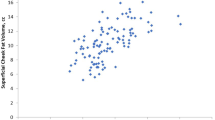Abstract
Background
The aim of this study was to derive the normal values for bone and soft tissue nasal angles as well as the overlying skin thickness and to attempt to determine the correlation between differences in bone and soft tissue angles and overlying skin thickness in Middle Eastern patients.
Materials and Methods
Three-dimensional cephalometric analysis was performed for 100 patients who underwent computed tomography of the paranasal sinuses. The nasofrontal angle, pyramidal angle-nasal root, pyramidal angle-tip of the nasal bone, and overlying skin thickness were measured, and the results were analyzed according to sex, age, and body mass index (BMI).
Results
All soft tissue angles were significantly larger than the bone angles, with the mean difference being 11.62°, 30.80°, and 27.05° for the nasofrontal angle (P = 0.000), pyramidal angle-nasal root (P = 0.000), and pyramidal angle-tip of the nasal bone (P = 0.000), respectively. The mean overlying skin thickness was 3.89 ± 1.48 mm at the nasion, 1.16 ± 0.6 mm at the rhinion, and 2.93 ± .97 mm at the nasal tip. Differences in the nasofrontal angle were strongly correlated with the skin thickness at the nasion (P = 0.001).
Conclusion
A simple clinical exam of the soft tissue nasal angles does not reflect the underlying bone angles that will be encountered during rhinoplasty. BMI does not influence nasal shape, and rhinoplasty surgery should take into account the ethnic group, age, and sex of the patient. Surgeons should leave a minor skeletal hump at the end of the nasal bone for Middle Eastern patients.
Level of Evidence IV
This journal requires that authors assign a level of evidence to each article. For a full description of these Evidence-Based Medicine ratings, please refer to the Table of Contents or the online Instructions to Authors www.springer.com/00266.


Similar content being viewed by others
References
Guyuron B (1988) Precision rhinoplasty. Part I: the role of life-size photographs and soft-tissue cephalometric analysis. Plast Reconstr Surg 81(4):489–499
Doddi NM, Eccles R (2010) The role of anthropometric measurements in nasal surgery and research: a systematic review. Clin Otolaryngol 35:277–283. https://doi.org/10.1111/j.1749-4486.2010.02169.x
Dong Y, Zhao Y, Bai S, Wu G, Zhou L, Wang B (2011) Three-dimensional anthropometric analysis of Chinese faces and its application in evaluating facial deformity. J Oral Maxillofac Surg 69:1195–1206. https://doi.org/10.1016/j.joms.2010.05.023
Husein OF et al (2010) Anthropometric and aesthetic analysis of the Indian American woman’s face. J Plast Reconstr Aesthet Surg 63:1825–1831. https://doi.org/10.1016/j.bjps.2009.10.032
Uzun A, Ozdemir F (2014) Morphometric analysis of nasal shapes and angles in young adults. Braz J Otorhinolaryngol 80:397–402. https://doi.org/10.1016/j.bjorl.2014.07.010
Moon KM et al (2013) Nasal anthropometry on facial computed tomography scans for rhinoplasty in Koreans. Arch Plast Surg 40:610–615. https://doi.org/10.5999/aps.2013.40.5.610
Cho GS, Kim JH, Yeo NK, Kim SH, Jang YJ (2011) Nasal skin thickness measured using computed tomography and its effect on tip surgery outcomes. Otolaryngol Head Neck Surg 144:522–527. https://doi.org/10.1177/0194599811398936
Kim KD, Ruprecht A, Wang G, Lee JB, Dawson DV, Vannier MW (2005) Accuracy of facial soft tissue thickness measurements in personal computer-based multiplanar reconstructed computed tomographic images. Forensic Sci Int 155:28–34. https://doi.org/10.1016/j.forsciint.2004.11.004
Ha RY, Nojima K, Adams WP Jr, Brown SA (2005) Analysis of facial skin thickness: defining the relative thickness index. Plast Reconstr Surg 115:1769–1773
Sahni D, Sanjeev SG, Jit I, Singh P (2008) Facial soft tissue thickness in northwest Indian adults Forensic. Sci Int 176:137–146. https://doi.org/10.1016/j.forsciint.2007.07.012
Phillips VM, Smuts NA (1996) Facial reconstruction: utilization of computerized tomography to measure facial tissue thickness in a mixed racial population. Forensic Sci Int 83:51–59
Steele N, Thomas J (2009) Surgical anatomy of the nose. In: Stucker F, de Souza C, Kenyon G, Lian T, Draf W, Schick B (eds) Rhinology and facial plastic surgery. Springer, Berlin, Heidelberg. https://doi.org/10.1007/978-3-540-74380-4_1
Rohrich RJ, Ghavami A (2009) Rhinoplasty for middle eastern noses. Plast Reconstr Surg 123:1343–1354. https://doi.org/10.1097/PRS.0b013e31817741b4
Whitaker EG, Johnson CM Jr (2002) Skin and subcutaneous tissue in rhinoplasty. Aesthetic Plast Surg 26(Suppl 1):S19. https://doi.org/10.1007/s00266-002-4323-5
Al-Qattan MMA, Alsaeed AA, Al-Madani OK, Al-Amri NA, Al-Dahian NA (2012) Anthropometry of the Saudi Arabian nose. J Craniofac Surg 23:821–824. https://doi.org/10.1097/SCS.0b013e31824dfa69
Acknowledgements
The authors extend their appreciation to the International Scientific Partnership Program ISPP at King Saud University for funding this research work through ISPP# 007.
Author information
Authors and Affiliations
Corresponding author
Ethics declarations
Conflict of interest
The authors declare that they have no conflicts of interest to disclose.
Ethical Approval
All procedures performed in studies involving human participants were in accordance with the ethical standards of the institutional and/or national research committee and with the 1964 Declaration of Helsinki and its later amendments or comparable ethical standards. For this type of study, formal consent is not required.
Rights and permissions
About this article
Cite this article
Alharethy, S., Alohali, S., Alquniabut, I. et al. Bone and Soft Tissue Nasal Angles Discrepancies and Overlying Skin Thickness: A Computed Tomography Study. Aesth Plast Surg 42, 1085–1089 (2018). https://doi.org/10.1007/s00266-018-1127-9
Received:
Accepted:
Published:
Issue Date:
DOI: https://doi.org/10.1007/s00266-018-1127-9




